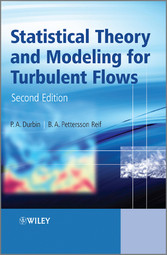Suchen und Finden
Statistical Theory and Modeling for Turbulent Flows
3
Contents
9
Preface
13
Preface to second edition
13
Preface to first edition
13
Motivation
14
Epitome
15
Acknowledgements
15
Part I FUNDAMENTALS OF TURBULENCE
17
1 Introduction
19
1.1 The turbulence problem
20
1.2 Closure modeling
25
1.3 Categories of turbulent flow
26
Exercises
30
2 Mathematical and statistical background
31
2.1 Dimensional analysis
31
2.1.1 Scales of turbulence
34
2.2 Statistical tools
35
2.2.1 Averages and probability density functions
35
2.2.2 Correlations
41
2.3 Cartesian tensors
50
2.3.1 Isotropic tensors
52
2.3.2 Tensor functions of tensors; Cayley–Hamilton theorem
53
Exercises
58
3 Reynolds averaged Navier–Stokes equations
61
3.1 Background to the equations
62
3.2 Reynolds averaged equations
64
3.3 Terms of kinetic energy and Reynolds stress budgets
65
3.4 Passive contaminant transport
70
Exercises
72
4 Parallel and self-similar shear flows
73
4.1 Plane channel flow
74
4.1.1 Logarithmic layer
77
4.1.2 Roughness
79
4.2 Boundary layer
81
4.2.1 Entrainment
85
4.3 Free-shear layers
86
4.3.1 Spreading rates
92
4.3.2 Remarks on self-similar boundary layers
92
4.4 Heat and mass transfer
93
4.4.1 Parallel flow and boundary layers
94
4.4.2 Dispersion from elevated sources
98
Exercises
102
5 Vorticity and vortical structures
107
5.1 Structures
109
5.1.1 Free-shear layers
109
5.1.2 Boundary layers
113
5.1.3 Non-random vortices
118
5.2 Vorticity and dissipation
118
5.2.1 Vortex stretching and relative dispersion
120
5.2.2 Mean-squared vorticity equation
122
Exercises
124
Part II SINGLE-POINT CLOSURE MODELING
125
6 Models with scalar variables
127
6.1 Boundary-layer methods
128
6.1.1 Integral boundary-layer methods
129
6.1.2 Mixing length model
131
6.2 The k –å model
137
6.2.1 Analytical solutions to the k –å model
139
6.2.2 Boundary conditions and near-wall modifications
144
6.2.3 Weak solution at edges of free-shear flow; free-stream sensitivity
151
6.3 The k –ù model
152
6.4 Stagnation-point anomaly
155
6.5 The question of transition
157
6.5.1 Reliance on the turbulence model
160
6.5.2 Intermittency equation
161
6.5.3 Laminar fluctuations
163
6.6 Eddy viscosity transport models
164
Exercises
168
7 Models with tensor variables
171
7.1 Second-moment transport
171
7.1.1 A simple illustration
172
7.1.2 Closing the Reynolds stress transport equation
173
7.1.3 Models for the slow part
175
7.1.4 Models for the rapid part
178
7.2 Analytic solutions to SMC models
185
7.2.1 Homogeneous shear flow
185
7.2.2 Curved shear flow
188
7.2.3 Algebraic stress approximation and nonlinear eddy viscosity
192
7.3 Non-homogeneity
195
7.3.1 Turbulent transport
196
7.3.2 Near-wall modeling
197
7.3.3 No-slip condition
198
7.3.4 Nonlocal wall effects
200
7.4 Reynolds averaged computation
210
7.4.1 Numerical issues
211
7.4.2 Examples of Reynolds averaged computation
214
Exercises
229
8 Advanced topics
233
8.1 Further modeling principles
233
8.1.1 Galilean invariance and frame rotation
235
8.1.2 Realizability
237
8.2 Second-moment closure and Langevin equations
240
8.3 Moving equilibrium solutions of SMC
242
8.3.1 Criterion for steady mean flow
243
8.3.2 Solution in two-dimensional mean flow
244
8.3.3 Bifurcations
247
8.4 Passive scalar flux modeling
251
8.4.1 Scalar diffusivity models
251
8.4.2 Tensor diffusivity models
252
8.4.3 Scalar flux transport
254
8.4.4 Scalar variance
257
8.5 Active scalar flux modeling: effects of buoyancy
258
8.5.1 Second-moment transport models
261
8.5.2 Stratified shear flow
262
Exercises
263
Part III THEORY OF HOMOGENEOUS TURBULENCE
265
9 Mathematical representations
267
9.1 Fourier transforms
268
9.2 Three-dimensional energy spectrum of homogeneous turbulence
270
9.2.1 Spectrum tensor and velocity covariances
271
9.2.2 Modeling the energy spectrum
273
Exercises
282
10 Navier–Stokes equations in spectral space
285
10.1 Convolution integrals as triad interaction
285
10.2 Evolution of spectra
287
10.2.1 Small-k behavior and energy decay
287
10.2.2 Energy cascade
289
10.2.3 Final period of decay
292
Exercises
293
11 Rapid distortion theory
297
11.1 Irrotational mean flow
298
11.1.1 Cauchy form of vorticity equation
298
11.1.2 Distortion of a Fourier mode
301
11.1.3 Calculation of covariances
303
11.2 General homogeneous distortions
307
11.2.1 Homogeneous shear
309
11.2.2 Turbulence near a wall
312
Exercises
316
Part IV TURBULENCE SIMULATION
319
12 Eddy-resolving simulation
321
12.1 Direct numerical simulation
322
12.1.1 Grid requirements
322
12.1.2 Numerical dissipation
324
12.1.3 Energy-conserving schemes
326
12.2 Illustrations
329
12.3 Pseudo-spectral method
334
Exercises
338
13 Simulation of large eddies
341
13.1 Large eddy simulation
341
13.1.1 Filtering
342
13.1.2 Subgrid models
346
13.2 Detached eddy simulation
355
Exercises
359
References
361
Index
369
Alle Preise verstehen sich inklusive der gesetzlichen MwSt.







